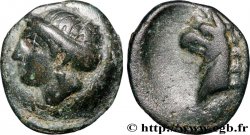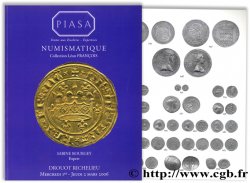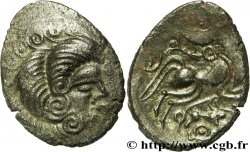v10_0073 - 5 francs Napoléon Empereur, type intermédiaire 1804 Paris F.302/1
MONNAIES 10 (2000)
Starting price : 3 811.23 €
Estimate : 7 622.45 €
Realised price : 7 698.68 €
Starting price : 3 811.23 €
Estimate : 7 622.45 €
Realised price : 7 698.68 €
Type : 5 francs Napoléon Empereur, type intermédiaire
Date: An 12 (1803-1804)
Mint name / Town : Paris
Quantity minted : 766731
Metal : silver
Millesimal fineness : 900 ‰
Diameter : 37 mm
Orientation dies : 6 h.
Weight : 25,01 g.
Edge : inscrite en creux * DIEU PROTEGE LA FRANCE
Rarity : R1
Coments on the condition:
Avant tout, la qualité artistique de la gravure du type est exceptionnelle, imprégnée de l'idée romaine du portrait monétaire, empreinte autant de dépouillement que de force : ce n'est pas un hasard si c'est le type monétaire, en écu français, où la surface du champ, relativement à celle des reliefs, est la plus grande - par contraste, le portrait semble encore plus idéalisé. La qualité de la frappe, exceptionnelle, renforce cet aspect. La force avec laquelle le métal s'est imprégné dans le coin a levé les oves du listel, parfaitement régulières, en une sorte de couronne qui délimite la monnaie dans l'espace, rajoutant encore à l'aspect "frappe d'épreuve" de cet exemplaire d'exception. La tranche, merveilleusement régulière et énergique, porte, comme sur l'exemplaire de l'an XI, ce "deuxième listel", lignes circulaires pointillées qui encadrent le texte et sont simplement les plats des oves du listel telles que vues depuis la tranche. La préparation du coin et du flan a créé un contraste entre les champs brillants et le très léger velours du portrait et de la légende NAPOLEON EMPEREUR qui augmente l'impression de relief : le portrait semble plus une sculpture qu'une effigie monétaire. La patine, très discrète au droit et légèrement plus soutenue au revers, renforce aussi le contraste car elle est presque inexistante sur le léger velours du portrait. Au revers, la patine s'est surtout concentrée avec des reflets rouges autour des lettres et de la couronne de lauriers, quelques reflets bleus apparaissant à la périphérie. On voit même au-dessus des lettres, à droite et à gauche du revers, les petits rectangles clairs dans la patine qui marquent les rebords supérieurs dans un "effet d'ombre" très net.
Une analyse plus technique de la pièce explique pourquoi elle n'est échelonnée qu'à 64. Les seuls défauts visibles à l'œil sont une infime égratignure sur le maxillaire, de subtiles traces de cheveux dans le brillant du champ et une faiblesse sur deux oves du listel, à 12 heures, causée par un infime manque de métal dans le flan. À la loupe, les traces de cheveux sont nettement visibles et quelques égratignures se révèlent tant au droit qu'au revers, par exemple devant le 5 ou sur le sourcil.
La rareté du type en état exceptionnel est extrême : notre confrère et néanmoins ami Victor Gadoury a traîné pendant longtemps comme illustration dans son catalogue la photo d'un moulage, puis un exemplaire élimé et ce n'est qu'avec l'arrivée de la nouvelle équipe que l'illustration a été faite à partir d'un superbe exemplaire. C'est dire la rareté de cette monnaie en état superbe ou mieux que superbe ! En conclusion, même simplement en SPL 64, le tout forme un ensemble extraordinaire, a un impact visuel sans équivalent et, à mon avis, cette pièce est le plus bel écu français, esthétiquement parlant, tous exemplaires et types confondus de l'An 4 à 1889
Catalogue references :
Obverse
Obverse legend : NAPOLEON EMPEREUR..
Obverse description : Tête nue de Napoléon Ier à droite ; TIOLIER sur la tranche de l'épaule.
Reverse
Reverse legend : RÉPUBLIQUE FRANÇAISE. / .(DIFFÉRENT). AN 12. .(LETTRE D'ATELIER)..
Reverse description : 5 / FRANCS., en deux lignes, dans une couronne composée de deux branches d'olivier, nouées à leur base par un ruban.
Commentary
Cet exemplaire est celui de la Collection Idéale. Il illustre le type dans le FRANC III en couleurs et est la pièce de couverture du FRANC III.
This example is from the Ideal Collection. It illustrates the type in FRANC III in color and is the cover piece of FRANC III.
This example is from the Ideal Collection. It illustrates the type in FRANC III in color and is the cover piece of FRANC III.








 Report a mistake
Report a mistake Print the page
Print the page Share my selection
Share my selection Ask a question
Ask a question Consign / sell
Consign / sell
 Full data
Full data















